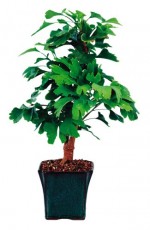 Also known as the maidenhair tree, this deciduous tree is native to China. It is considered a living fossil because it has been on earth for 270 million years as indicatged by fossil evidence. The relationship of gingko to other plants is uncertain and it is classified alone in the division Ginkophyta. Gingkos are tolerant of poor growing conditions and often used in urban settings because of their pollution tolerance. Male and female reproductive structures are found on different trees and only female trees produce a fruit-like structure. The fruit has a sickly smell but fortunately bonsai specimens will not produce them. The attractive fan-shaped leaves are green in spring and summer before turning bright yellow in the fall.
Also known as the maidenhair tree, this deciduous tree is native to China. It is considered a living fossil because it has been on earth for 270 million years as indicatged by fossil evidence. The relationship of gingko to other plants is uncertain and it is classified alone in the division Ginkophyta. Gingkos are tolerant of poor growing conditions and often used in urban settings because of their pollution tolerance. Male and female reproductive structures are found on different trees and only female trees produce a fruit-like structure. The fruit has a sickly smell but fortunately bonsai specimens will not produce them. The attractive fan-shaped leaves are green in spring and summer before turning bright yellow in the fall.
Position: Gingkoes require a dormant period so should be grown outdoors. The best fall coloration is produced when the plant is grown in full sun but some shade is needed in summer by young plants. The roots must be protected from severe or prolonged cold making an indoor site in an unheated garage is a good choice for winter care.
Water: Give plenty of water during the growing season but decrease water in winter so that the roots are barely moist.
Fertilizer: Use a balanced fertilizer at half strength every two weeks during the growing season, reducing the concentration by another half during the winter.
Repotting: Repot in the spring before the plant starts to grow every one to three years depending on the age of the plant; young plants need more frequent repotting that older ones. Root prune lightly.
Soil: Use a soil that has about 40% sand to ensure good drainage.
Pruning: Pruning must be done very carefully because the bark scars easily and may not recover. Prune new shoot back to two leaves preferably in spring; prune new branches back to two or three buds in spring or fall.
Wiring: Wire if necessary from spring to autumn, checking periodically to make sure the wire is not damaging the bark.
Propagation: Semi-ripe cuttings in spring and summer, hardwood cuttings in winter
To buy Gingko bonsai from Amazon.com Click Here.